When it comes to producing quality smart speakers, Sonos has been in the game for quite some time. They have produced a large line of well-respected products that provide excellent audio quality and useful smart features, and that sort of dominance has attracted the attention of other brands. Imitation may be the sincerest form of flattery, but Sonos’ competitor Denon takes that imitation to a whole new extreme.
In addition to copying the same sort of naming mechanism with the addition of their HEOS 3, HEOS 5 and HEOS 7 speakers, they also mirrored Sonos’ strategy of offering different sizes of speakers for different types of situations.
It’s clear that Sonos didn’t appreciate the “flattery”, as they’ve responded to Denon’s imitation with a lawsuit that Denon is still trying to fight. However, rather than adjusting their strategy, Denon has doubled down on their imitation by continuing to expand their product line at an impressive pace. In just two years, the brand has managed to introduce four stand-alone speakers, a soundbar/subwoofer combo, two different wireless receivers, a wireless range extender, and more. Recently, the company also revamped pretty much every single product in their lineup in order to add Bluetooth and hi-res audio support with a designation known as HS2 (make sure you’re looking for that label to find the newest models!)
Sonos, on the other hand, has taken a much more conservative approach to expansion with just one new product and the introduction of the Trueplay feature that allows you to tweak EQ settings using a smartphone mic.
Is this a situation where the imitation will surpass the original? Sonos at this point remains the top dog, but the gap continues to grow smaller and smaller.
Denon Heos 1 vs. Sonos PLAY:1
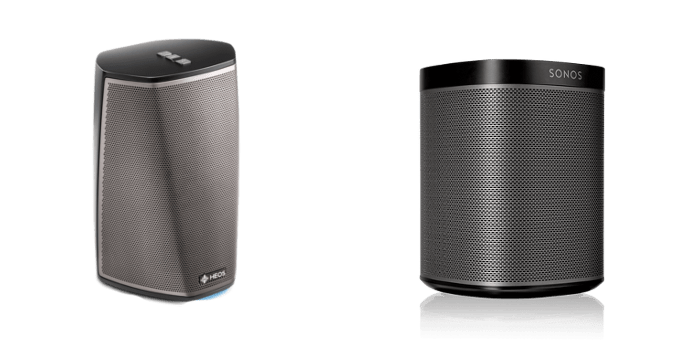
Despite both being their respective brands’ entry level model, there are some big differences when comparing the vs. .
The Sonos speaker is actually quite similar to the bigger and more premium models, being an indoor-only, WiFi speaker that you need to plug into a wall.
Conversely, the Denon Heos 1 HS2 took a completely different direction than the rest of the Denon line. Just like the rest of the models in the product family, it includes Bluetooth support in addition to WiFi, but it also allows you to take your speaker on the go, with no power cord required.
When you add on the optional $99 Go Pack battery, you can take your Heos 1 far from any electrical outlet, which is perfect for keeping the kids entertained while playing in the yard or for some relaxing mood music for a romantic picnic. You can even make your Heos 1 HS2 a staple at your next pool party due to the silicone splash guard — just keep in mind that it is not waterproof, so it’s better on the sidelines rather than in the pool itself!
In testing, most people did prefer the sound quality of the Sonos Play 1. However, the convenience of being able to take the Heos speaker with you on the go cannot be discounted. It’s essentially going to be a decision between whether you value superior audio quality or portability.
| Mono Output | Yes | Yes |
| Stereo Output | Only when paired with the same speaker | Only when paired with the same speaker |
| Class-D Digital Amplifiers | 2 | 2 |
| Tweeter | 1 | 1 |
| Mid-Woofer | 1 | 1 |
| Audio Line-in | No | Yes |
| USB Port | No | 1 |
| Ethernet Port | 1 | 1 |
| Bluetooth | No | Yes |
| Wireless Network | 802.11b/g, 2.4 GHz | 802.11a/b/g/n networks on 2.4GHz and 5Ghz bands |
| Placement | Vertical | Vertical |
No products found.
Denon Heos 3 vs. Sonos PLAY:3
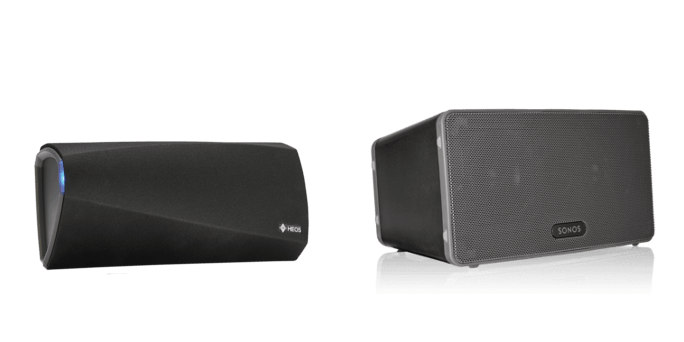
While the entry-level models of the Denon and Heos models were pretty different from one another, there aren’t too many differences to discuss when comparing the Heos 3 vs. Sonos 3.
Let’s talk first about audio quality. While which one sounds better is largely going to be personal preference due to the pretty similar design of both brands, the Sonos 3 does seem to have a bit of an edge due to the fact that it includes two mid-woofers rather than just one.
However, that extra mid-woofer is the only real advantage that the Sonos has over the Heos, while the Heos does have a number of extra utility features that make it a little more convenient to use. For example, the Heos 3 has an audio line-in while the Sonos 3 does not. It also supports Bluetooth connections which is a significant perk and has the ability to operating on 5GHz WiFi frequencies while the Sonos 3 is limited to 2.4GHz.
So, once again, you’ll likely get better sound with the Sonos speaker, but you’ll have more utility with the Heos.
| Sonos PLAY:3 | Denon Heos 3 | |
|---|---|---|
| Drivers | 3 | 3 |
| Tweeter | 1 | 1 |
| Mid-Woofer | 2 | 1 |
| Audio Line-in | No | Yes |
| USB Port | No | 1 |
| Ethernet Port | 1 | 1 |
| Bluetooth | No | Yes |
| Wireless Network | 802.11b/g, 2.4 GHz | 802.11a/b/g/n networks on 2.4GHz and 5Ghz bands |
| Placement | Vertical or Horizontal | Vertical or Horizontal |
Denon Heos 5 vs. Sonos PLAY:5

It’s at this point where a 1:1 comparison gets a little bit difficult. When the Denon Heos 5 first came onto the market, it was at a moderate disadvantage when compared to the Sonos PLAY:5. The HEOS 5 had four active drivers and amps and one passive bass radiator, while the Play 5 had five active drivers and amps. Just from a technology standpoint alone, it was easy to see that the Sonos model had a bit of an advantage.
However, in 2014, Sonos released the second-generation Play 5 with significantly upgraded specifications. It features a new design, and six drivers and amps — putting it far ahead of the Heos 5 in terms of sound quality. However, not to be outdone, Denon released the Heos 7, which seems to exceed even the upgraded Play 5. So we end up in a situation where the Play 5 falls pretty much right in the middle of the Heos 5 and the Heos 7. For that reason, we’ll compare this Sonos speaker to both Denon models.
The new Play 5 takes the Sonos brand in a new direction — likely to get out and ahead of the crowd of competitors and imitators like Denon. It has a very minimalistic design, with a rounded-obelisk shape and smooth contours that make the speaker feel very classy and sleek. In lieu of the volume, mute and pause buttons, Sonos has introduced touch-based versions with a new swiping gesture for skipping forward or back on your playlists.
The design and the sound quality are superior to the Heos 5, so if you’re deciding between those two models you’ll likely be happier with the Sonos model. However, all bets are off when you consider the power of the Heos 7 — more on that below!
| Sonos PLAY:5 (Gen 2) | Denon Heos 5 | |
|---|---|---|
| Class-D Digital Amplifiers | 6 | 5 |
| Tweeter | 3 | 2 |
| Mid-Woofer | 3 | 2 |
| Audio Line-in | Yes | Yes |
| USB Port | No | 1 |
| Ethernet Port | 1 | 1 |
| Bluetooth | No | Yes |
| Wireless Network | 802.11b/g, 2.4 GHz | 802.11a/b/g/n networks on 2.4GHz and 5Ghz bands |
| Placement | Vertical or Horizontal | Horizontal |
Denon Heos 7 vs. Sonos PLAY:5
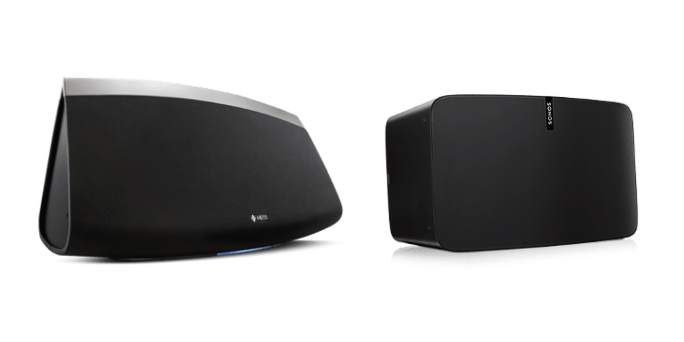
While the Sonos PLAY:5 is an incredibly attractive speaker, the top-of-the-line Heos 7 is also an incredibly attractive design. The angular styling is a very unique format for a speaker, and gives the Heos line a bit of its own identity rather than riding on the design decisions of the Sonos line.
The Heos 7 flat out has a better sound quality when compared to the Play 5. This gap becomes less noticeable when you pair two Sonos speakers together, but on its own the superiority of this Denon speaker is clear. Two Play 5’s offers superior performance when you consider that you can pair two Heos 7 speakers together as well, the high-end performance of the 7 is just difficult to beat.
Testers have reported that the Denon speaker does a better job of handling all aspects of sound — producing excellent quality on treble, bass, and the midrange. The Heos 7 is a good amount more expensive than the Play 5, but we feel that it’s a superior speaker even when factoring in the price differences — the sound is just that good!
If the high-end sound quality isn’t enough of a reason to buy, consider the increased versatility of the Heos 7 as well. It features analog inputs, a headphone jack, a USB port, as well as a USB audio playback — putting its utility far ahead of the Sonos speaker. Additionally, it offers the option for Bluetooth pairing in addition to the dedicated WiFi-enabled multi-room network.
Long story short, there’s really no competition here. The high-end Heos 7 comes out far ahead of the Sonos Play 5.
| Sonos PLAY:5 (Gen 2) | Denon Heos 7 | |
|---|---|---|
| Class-D Digital Amplifiers | 6 | 5 |
| Tweeter | 3 | 2 |
| Mid-Woofer | 3 | 2 |
| Woofer | N/A | 1 |
| 3.5mm Headphone Output Jack | No | Yes |
| Audio Line-in | Yes | Yes |
| USB Port | No | 1 |
| Ethernet Port | 1 | 1 |
| Bluetooth | No | Yes |
| Wireless Network | 802.11b/g, 2.4 GHz | 802.11a/b/g/n networks on 2.4GHz and 5Ghz bands |
| Placement | Vertical or Horizontal | Horizontal |
Denon Heos Bar vs. Sonos Playbar
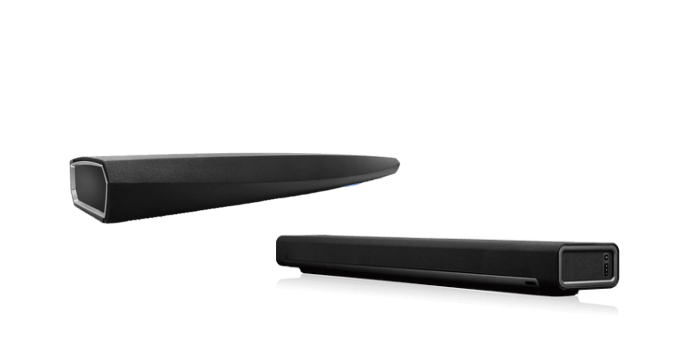
When comparing the Denon Heos Bar vs. Sonos Playbar, this is another situation where the technology and features are quite similar. However, we do feel that the Heos pulls slightly ahead due to the inclusion of the HDMI connection as well as a generally more impressive sound.
Considering that you’re most likely to use your soundbar for a home entertainment system, the inclusion of HDMI connections is a no-brainer — yet for some reason, the Sonos Playbar omits these ports while the Heos bar includes them. In terms of the rest of the technology, the two models are quite similar — though the Heos model does support Bluetooth connections while the Playbar does not.
With that said, the Heos Bar isn’t necessarily perfect. We feel that it’s better than the Sonos Playbar, but the app lacks the ability to easily tweak sound settings, and the USB slot is rather inconvenient to access.
Out of all of the products in this comparison, the Heos Bar and Sonos Playbar are probably the most similar. The main advantage that the Heos Bar has is the HDMI support which, while not necessarily groundbreaking, is enough of a perk to give it the edge.
| Sonos Playbar | Denon Heos Bar | |
|---|---|---|
| Drivers | 9 | 9 |
| Connect to TV | Via Digital Optical Cable | 4 HDMI Inputs, Digital Optical Cable |
| 3.5mm Headphone Output Jack | No | Yes |
| Audio Line-in | No | Yes |
| USB Port | No | 1 |
| Ethernet Port | 2 | 1 |
| Bluetooth | No | Yes |
| Wireless Network | 802.11b/g, 2.4 GHz | 802.11a/b/g/n networks on 2.4GHz and 5Ghz bands |
| IR Remote | No | Yes |
Denon Heos vs. Sonos — Bluetooth
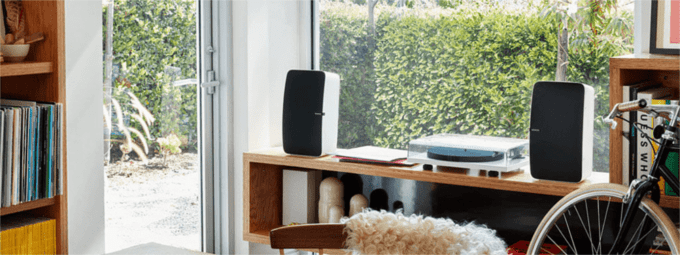
You may have noticed a trend when comparing the Denon Heos and Sonos speakers: The Heos line supports Bluetooth, while the Sonos line does not.
With the addition of Bluetooth on the entire HS2 line of Heos speakers, Denon has essentially made it possible to get crisp, clear audio without a WiFi connection. With a simple a long press of a button on any HS2 speaker, you’ll activate a pairing mode that can easily sync up to your Bluetooth-enabled device. You’ll be able to select your speaker from available Bluetooth devices on your phone and can then use the HEOS app or any other audio source on your phone in order to stream music.
As an added perk, once you’ve paired to one Heos speaker, you’ve paired to them all — making it easy to play audio into any room with a simple tap of a button.
The Bluetooth functionality is super convenient and makes it easier to allow your friends to play DJ for a bit. Rather than having to hook their devices into your network, it’s as simple as pressing a button and turning on Bluetooth to get tunes blasting with just a few seconds of work.
Denon Heos vs. Sonos — Software
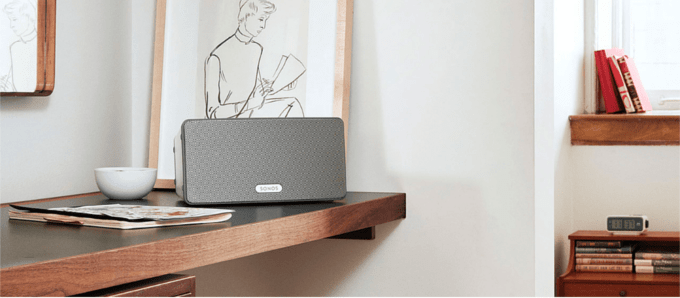
One area in which Sonos does have a significant advantage is Software. While Denon may have created some excellent smart speakers with technology that exceed that of Sonos at the high end, their app falls behind the utility and convenience of a Sonos app.
The software experience with Sonos is excellent in pretty much every way, from easy setup to a powerful universal search that puts all your tunes in one place. Over the past few years, however, we haven’t really seen anything revolutionary from Sonos on a software front outside of Trueplay and an update that can show album art and playback controls on the lock screen of iOS devices. However, it doesn’t really need to change too much because the app is so solid to begin with.
Denon hasn’t done much to improve their app recently either, but unlike Sonos, they don’t have the same solid base to pull from as far as software goes. Setting up the speakers is definitely less convenient that it is with Sonos, and you’ll need to use the included 3.5mm audio cable, a number of different button presses, monitor status lights, and input WiFi passwords in order to get everything online. It’s a far cry from how convenient Sonos setup is, and definitely makes the speakers a bit of a hassle to get going.
There are also some smaller drawbacks with the HEOS app, such as the inability to save specific tracks within the app. You can save playlists, but saving a single song as a Heos favorite is pretty much impossible. Navigation around the app is also a little more cumbersome, and it really makes you appreciate how polished Sonos is from a software standpoint.
It may seem from this article as a whole that Denon Heos has a significant advantage over Sonos, and they do in a way as far as the speakers themselves go. However, the poor software experience really holds them back from competing with Sonos on an equal level. Smart speakers are all about adding more convenience, and the Denon Heos add is just a little less convenient than Sonos.
Denon Heos vs. Sonos — Our Thoughts
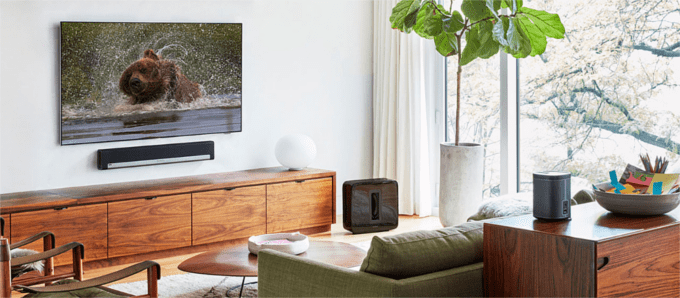
Denon is quickly creeping up on Sonos, and their speakers are actually superior in a lot of ways. The Denon Heos 7 is one of the most impressive smart speakers on the market and blows Sonos away even when you consider that it’s significantly more expensive. The addition of Bluetooth is also a significant advantage, as are the variety of ports and connections that give you more choice when it comes to playing your tunes.
However, we can’t really say that Denon Heos is the superior brand — almost entirely because of the poor software experience. All the smart speaker tech in the world is useless if it’s inconvenient to play music, and Sonos still has the edge in terms of usability despite having slightly lower-quality acoustics in some of their models.
If Denon irons out the issues with their software and continues to cater to Sonos’ Hi-Fi market, they may start to be a significant threat to Sonos. At this point, however, it seems like Sonos still reigns supreme over the smart speaker market as a whole.
Last update on 2024-04-25 at 17:33 / Affiliate links / Images from Amazon Product Advertising API









Any update to airplay 2 support on the Heos line? I currently own 2 Heos 1’s and a Denon x6400 AVR with Heos and looking to buy a heos 7 buton the fence-to see if Denon will support AirPlay 2 with a software update on HS2 or introduce HS3. Can you provide any info on airplay 2 support on Heos speakers
Hi Roshan!
As of now only the HEOS Home Cinema HS2 is compatible to AirPlay 2. Check out this list of AirPlay 2 compatible devices for Denon, Marantz, and HEOS.
On a side note, Sonos Play:5, Playbase, and Sonos One support AirPlay 2, so there’s a chance that HEOS will roll an update to support AirPlay 2. However, the truth is that the HEOS line of speakers just might not have enough horsepower to support AirPlay 2. We’ll keep an eye on it and hope for the best, but it is what it is right now.
Great article, clear and easy to understand.
Very helpful post…….
I wonder if you compared the sound of the Sonos after using Trueplay? It does make quite a difference after Sonos eq’s the speakers for the room characteristics. I would also emphasize that the “remote” or the software GUI is your primary point of interaction so it does hold a very important role in the overall product satisfaction. One of the most important assets for me in relation to using Sonos products is their direct integration onto software like Spotify, Insteon (smart lighting) and Logitech Harmony remotes
Very good article. I am thinking of eschewing the soundbar, and just going for and pairing two Helo’s 7’s. What are your thoughts about adding a Bass unit? I am buying mostly for music listening, although it will be connected to new Samsung 65″. This TV has AirPlay 2. I assume I could use that function to tie in with either the Denon or Sonos system. Is that correct? I saw Costco has the Sono’s Bass and I have read very good reviews. I have not seen much on the Denon. This is for a beach house.